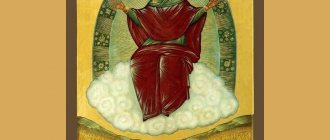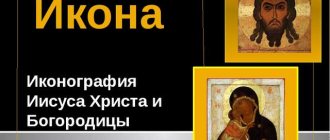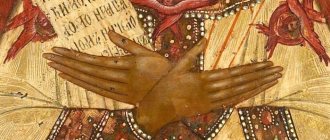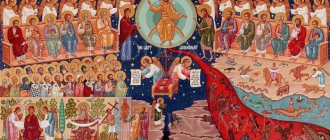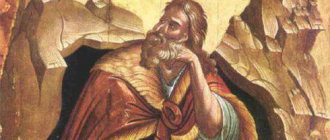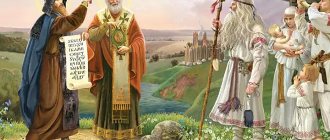History of the icon
The icon of St. Nicholas the Wonderworker is known throughout the world as a prototype of the great Saint. Even Buddhists worship him. For them, Nicholas the Wonderworker is the patron saint of prosperity. His generosity during his lifetime is legendary. There is a well-known story when girls in a poor family did not have enough money to get married, and they wanted to give them to concubines. To be a concubine in ancient times meant to become a slave.
Nicholas, guided by the highest moral law, secretly threw bags of gold into their windows at night so that they could spend it on a dowry. According to other beliefs, stories about Santa Claus are associated with the name of the Saint. He threw bags of gold through the chimney into the girls' stockings, which they placed above the fireplace. Thus, the traditions of Catholicism appeared in the West.
In old age, the Wonderworker went to God. His relics are kept in the local cathedral church and exude healing myrrh. From this miracle, many received healing from serious illnesses.
Icon of St. Nicholas the Wonderworker in history
On the Icon the wonderworker is depicted with the Gospel in his hands. His face personifies the image of the Saint, preaching the gospel to the world. The relics of the Saint are located in the Italian town of Bari. In silver
The cost of icons from different eras varies. When calculating the price, the history of the image is also taken into account. Over the course of many centuries, the features of the Saint “on immortal canvases” have been preserved. During his lifetime, Nikola was the archbishop of Myra in Lycia. His images are still preserved on the walls of Roman churches. They often decorated the walls of Byzantine monasteries.
The standard image shows the Saint blessing with his right hand and holding the Gospel in his left. Such faces can often be seen in the form of mosaics on the walls of cathedrals. For example, in the St. Sophia Cathedral, St. George's Cathedral in Staraya Ladoga. Images of Nicholas are copied from the icon in the Sinai monastery, in the margins of which other great saints are visible.
You can often find joint images of St. Nicholas the Wonderworker, the Mother of God and Christ, which return to him the attributes of bishop's dignity. This is a captured vision that appeared after the Saint was unjustly imprisoned. Another image was painted after the story of Nikolai’s miraculous rescue of Prince Novgorod from a serious illness. According to legends, the icon sailed to the residents of Novgorod by water.
The icon of Nicholas of Mozhaisk has become known to the people since the 15th century. According to legends, after an enemy raid, the Myra saint appeared to the soldiers defending Mozhaisk. He towered over the cathedral with his blade raised high to the top. The enemies, frightened by this miracle, fled, and the inhabitants made wooden figurines in the likeness of this vision and beautiful icons.
The icon called Nikolai Zaraisky is also known today. He is depicted in full growth with outstretched arms. In his left hand he holds the Gospel. There are many other images that are filled with one meaning or another and are of great value not only for the spiritual world, but also for ordinary people.
During his life, Nicholas the Wonderworker accomplished many other glorious things. For example, he saved three husbands from death, condemned by self-interested bosses. The Wonderworker boldly stopped the raised sword above the heads of the men. The mayor began to pray to the elder for deliverance for his slander. This scene took place in front of several other military leaders, who were unaware of the imminent death sentence. But Nicholas also interceded for these people, who appeared to Equal-to-the-Apostles Constantine in a dream.
Another story is connected with a drowned child, which later received the name “The Miracle of a Certain Drowned Child, St. Nicholas Keeping Him Alive.” This story is dedicated to how once a woman swam from Vyshgorod to Kyiv and dropped her child into the water. The parents' grief knew no bounds, and they began to pray to St. Nicholas the Wonderworker. That same night, in the Sophia Monastery, a living wet baby was discovered near the divine face of the Saint. The parents of the drowned man soon found their baby. It was the icon in front of which the baby was discovered that began to be called the icon of Nicholas the Wet and was kept in the St. Sophia Cathedral for many years.
Icons in frames
The cost of icons of St. Nicholas the Wonderworker in a brass, silver or gold setting varies. You can describe one of the Orthodox icons made in Italy. It is placed on a wooden frame. The canvas is decorated with silk-screen printing and the frame is plated with silver. The front part of the icon is covered with 998 sterling silver. There are also gold parts. Inside the icon there is a manufacturer's certificate. The prices for icons in frames are as follows:
- icon of St. Nicholas the Wonderworker in a silver frame on wood – 202,480 rubles;
- large icon of St. Nicholas the Wonderworker – 202,000 rubles;
- Nicholas the Wonderworker, gold – 225,000 rubles.
Icon of St. Nicholas the Wonderworker, 19th century
Such an icon is highly valued. Its market value today is 54,900 rubles. The wooden board was preserved quite well. Partly because she was subjected to constant image reconstruction work. This relic comes from Kholui. It is considered a folk icon, since it was originally created for the common people: inexpensive, beautiful and mysterious. This example stands out a little from the total number of other antique icons. The icon board is reinforced and thick. The image of the saint is bright and attractive. It is made simply and elegantly. Looking at the work, one can see the efforts of a master who did not even suspect that his work would be valued so highly.
Icon of St. Nicholas the Wonderworker, 18th century
The 18th century icon differs not much from its predecessors. The main difference is the price from 600,000 rubles and above. It all depends on how well the exhibit is preserved.
For example, an icon from 1803 will be valued at 300,000 or 400,000 rubles. A special primer varnish is applied on top of the icon; the reverse of the product is made of purple velvet. The image is painted with oil paints. The frame of the icon is corrugated silver, and on some parts you can see gold inserts.
On either side of the Saint are the Virgin Mary and Jesus Christ. This icon is known to many believers under the name “Nicene Miracle”.
If the Icon of St. Nicholas the Wonderworker appears in a house, then this marks protection and prosperity, which opens the door to this house. Therefore, even on an expensive exhibit, you should not save money.
- —>Constitutional Democrats —>
- —>SOCIAL DEMOCRATIC PLATFORM (UKRAINE) —>
- —>Communism is a criminal formation —>
All 220
On the Day of National Unity, the Patriarch consecrated the restored gate icon of St. Nicholas of Mozhaisky on the St. Nicholas Tower of the Moscow Kremlin. The return of the great shrine is a significant event for all of Russia, said head of the presidential administration Sergei Naryshkin, who was present at the ceremony.
What is the SIGNIFICANCE of this event FOR ALL OF RUSSIA?
The icon, walled up in the 30s of the last century, was found under a layer of plaster in the spring of this year. This image was moved to the Kremlin gates in 1491 and updated in the 16th-17th centuries. Before this, as a talisman of the city, a carved image of St. Nicholas with a sword and hail in his hands was installed over the Nikolsky Gate of the Kremlin, built in 1367 under Dmitry Donskoy.
The veneration of Nikola Mozhaisky in Rus', as all (Christian and pre-Christian) sources admit, was so deep that the Western world considers him a Russian saint (Russian Father Frost, as they say, is not at all the same as Western Santa Claus). In Rus', Nikola Mozhaisky was also called Mikola. “Mikola is the same God,” says a popular saying. Since the time of Peter I, He has been revered as the patron of the Russian Navy.
According to legend, the image of St. Nicholas of Mozhaisk, as he is depicted on the icon, was revealed to the Russians and their enemies in the sky with a sword raised high in one hand and a city-posad - a symbol of the humanized universe - in the other. Unlike other divine and saintly images, St. Nicholas of Mozhaisky is also depicted in the form of carved wooden sculptures, which are not characteristic of the Russian Christian tradition and which, like in Moscow, but long before it, were placed above the guard gates of Russian kremlins in the northern cities of Rus'.
During the Time of Troubles, when the sculpture of Nikola of Mozhaisky was taken to Lithuania and “disappeared in captivity” until 1619, hundreds of sculptural statues of Nikola spread throughout the Russian land right up to the Urals and Siberia. In many cities, images of the formidable St. Nicholas, writes the famous modern researcher academician of architecture Gennady Mokeev, unanimously raised their naked swords against their enemies, with all their symbolic appearance calling and blessing the Russian people to cleanse Orthodox Rus' from “filthy Lithuania and Poles”, from the Catholic invasion.
It was through those Kremlin gates, which were marked with the image of Nikola Mozhaisky, that the people's militia of Minin and Pozharsky burst into the Kremlin in 1612 when it was captured.
Now the name of Nikola Mozhaisk is often associated with the city of Mozhaisk, which was first mentioned in the chronicle of 1231. However, numerous archaeological sites - fortifications, sites, mounds - indicate that the surroundings of modern Mozhaisk were inhabited already in the Neolithic era.
This is what people of the pre-Christian Vedic tradition know about Nikolai Mozhaisky.
The truth about Nikola Mozhaisky is reliably preserved by all genres of folklore and the Russian Vedas. According to them, the Vedic Orthodoxy of Nikola Mozhaisky - Veles (from the Russian word mozhaesh, moga, can, see V. Dahl's Explanatory Dictionary) was known to the first townspeople on earth from the third mile of the universe, i.e. more than 30 thousand years ago. This, in particular, is told in the epic “Volkh Vseslavyevich”. Russian Vedas and folklore tell what miracles the Great Magus Veles performed. He gave the townspeople herds of cows and herds of horses, taught them agriculture and crafts, read and gave them the Book of the Vedas, for which he was popularly called the Wonderworker.
The epic “Sadko” also mentions the name of Nikola Mozhaisky, figuratively pointing to His role in the evolution of life from the beginning of the universe. The blue-flammable stone to which Sadko comes is the sacred stone Alatyr, located at the crossroads of roads to Prav, Nav and Yav. According to the epic, Sadko, finding himself at the bottom of the sea in the kingdom of Navi, learns the way back to his homeland from the son of Svarog Veles, who appears to him in the form of a gray-haired old man. In honor of him, Sadko, upon returning to Novgorod, erected temples to St. Nicholas of Mozhaisk.
Veles - Nikola always helps the human soul on the straight roads of the universe: in the blue sea - the cosmic abyss. At the bottom of the sea, a guest of Vodyanoy or the King of the Sea, Sadko actually metaphysically meets the Almighty - Svarog. When Svarog goes on vacation, which happens when changing cosmic miles, the control of the universe is performed by Veles - Nikola, appointed by Father Svarog to guard the gates of Rule. Only the guardian of the gate of Prav, Svarozhich Veles, can let Sadko through the kingdom of death of Nav into the divine abode and help him return from Prav to Reality.
Veles, the patron saint of the Earth and all its inhabitants, taught people sorcery. Veles' disciples were the sorcerers-heroes Boyan and Khodynya - the creators of "The Tale of Igor's Campaign"; the image of Vasily Buslaev was based on Veles, who was violent in his youth. Korinthsky in his collection “People’s Rus'” conveys the people’s perception of the gray-haired old man Nikola-Veles in this way: He appears “either in the form of a kind grandfather (Mikola the Merciful), then his appearance passes with the heroic gait ... of Mikula Selyanovich.”
Now, according to Russian tradition, the sixth verst of the universe has begun, therefore the image of the miracle worker is being revealed throughout all of Rus', the keepers of the Vedic tradition emphasized in a conversation with me. Nikola-Veles is now walking across the expanses of the earth, especially the Russian Severau, and gladdens the hearts of people. In temples, chapels, icons, sculptures and other countless monuments, His Divine image is presented as a guardian of the gates of the kingdom of eternity - the divine abode - from unwanted penetration from the kingdom of Navi - Koshchei's kingdom of death.
In Veliky Novgorod, on Velesovaya Street (now Volosovaya) there is a temple to Veles (now Blasius). “The Tale of Bygone Years” calls Svarozhich Veles – “Hair, the God of Cattle.” Bible preachers who came from Byzantium borrowed the virtues of Veles, and churches in Rus' in his honor were renamed the churches of Blasius, the Sebastian bishop, and St. Nicholas the Saint, the mythical Italian bishop from Myra and Lycia.
The Church, the keepers of the Russian tradition emphasized, appropriated the virtues of the miracle worker Nikola - Veles, wanting people's Rus' to forget the parental family of Svarog, and on parental days - holidays to honor unknown foreign “martyrs-pleasers”. However, Russians still celebrate parental holidays in honor of Nikola Mozhaisky: May 9 - Spring Nikola, July 27 - Rocking Nikola, December 6 - Winter Nikola or Bratchina. No matter how hard the heirs of the Byzantine church try, the proverb answers them: “The brotherhood does not bow to the priest’s court.” In honor of Veles-Nikola, the people also cheerfully celebrate the New Year's Eve lavish evening, Maslenitsa and Yarilin week and other holidays.
The glorification of Nikola Mozhaisky on the Nikolskaya Tower of the Kremlin on National Unity Day this year coincided with a period of active discussion among Russian liberals, in particular among the Russian leadership, of various options for integration or even Russia's entry into NATO. This is perceived by many in the country as another stage of low-level bowing and capitulation to the West. It is symbolic that the inspirer of the Russian Spirit, the Divine Sword-Bearer and Wonderworker Nikola of Mozhaisky, has always served and continues to serve as protection from invasion from the West: from the side of Koshcheev’s kingdom of death.
Saint Nicholas the Wonderworker “Nicholas the Abominable”, board 8*10 cm
The Life of St. Nicholas, Archbishop of Myra in Lycia, Wonderworker
Saint Nicholas, Archbishop of Myra of Lycia, wonderworker , became famous as a great saint of God. He was born in the city of Patara, Lycian region (on the southern coast of the Asia Minor Peninsula), and was the only son of pious parents Theophanes and Nonna, who vowed to dedicate him to God. The fruit of long prayers to the Lord of childless parents, the baby Nicholas from the day of his birth showed people the light of his future glory as a great wonderworker. His mother, Nonna, was immediately healed of her illness after giving birth. The newborn baby, still in the baptismal font, stood on his feet for three hours, unsupported by anyone, thereby giving honor to the Most Holy Trinity . Saint Nicholas began a life of fasting in infancy, taking his mother's milk on Wednesdays and Fridays only once, after the evening prayers of his parents.
From childhood, Nikolai excelled in the study of Divine Scripture; During the day he did not leave the temple, and at night he prayed and read books, creating within himself a worthy dwelling of the Holy Spirit. His uncle, Bishop Nicholas of Patara, rejoicing at the spiritual success and high piety of his nephew, made him a reader, and then elevated Nicholas to the rank of priest, making him his assistant and instructing him to speak instructions to the flock. While serving the Lord, the young man was burning in spirit, and in his experience in matters of faith he was like an old man, which aroused the surprise and deep respect of the believers. Constantly working and vigilant, being in unceasing prayer, Presbyter Nicholas showed great mercy to his flock, coming to the aid of the suffering, and distributed all his property to the poor. Having learned about the bitter need and poverty of one previously rich resident of his city, Saint Nicholas saved him from great sin. Having three adult daughters, the desperate father planned to give them over to fornication to save them from hunger. The saint, grieving for the dying sinner, secretly threw three bags of gold out his window at night and thereby saved the family from fall and spiritual death. When giving alms, Saint Nicholas always tried to do it secretly and hide his good deeds.
Going to worship the holy places in Jerusalem, the Bishop of Patara entrusted the management of the flock to Saint Nicholas , who performed obedience with care and love. When the bishop returned, he, in turn, asked for a blessing to travel to the Holy Land. On the way, the saint predicted an approaching storm that threatened to sink the ship, for he saw the devil himself entering the ship. At the request of desperate travelers, he pacified the sea waves with his prayer. Through his prayer, one ship's sailor, who fell from the mast and fell to his death, was restored to health.
Having reached the ancient city of Jerusalem, Saint Nicholas , ascending Golgotha, thanked the Savior of the human race and walked around all the holy places, worshiping and praying. At night on Mount Zion, the locked doors of the church opened by themselves in front of the great pilgrim who came. Having visited the shrines associated with the earthly ministry of the Son of God , Saint Nicholas decided to retire into the desert, but was stopped by a Divine voice, exhorting him to return to his homeland. Returning to Lycia, the saint, striving for a silent life, entered the brotherhood of the monastery called Holy Zion. However, the Lord again announced a different path awaiting him: “Nicholas, this is not the field in which you must bear the fruit I expect; but turn and go into the world, and may My Name be glorified in you.” In a vision, the Lord gave him the Gospel in an expensive setting, and the Most Holy Mother of God - an omophorion.
And indeed, after the death of Archbishop John, he was elected Bishop of Myra in Lycia after one of the bishops of the Council, which was deciding the issue of electing a new archbishop, was shown in a vision the chosen one of God - Saint Nicholas . Called to shepherd the Church of God in the rank of bishop, Saint Nicholas remained the same great ascetic, showing to his flock the image of meekness, gentleness and love for people. This was especially dear to the Lycian Church during the persecution of Christians under the emperor Diocletian (284–305). Bishop Nicholas, imprisoned along with other Christians, supported them and exhorted them to firmly endure the bonds, torture and torment. The Lord preserved him unharmed. Upon the accession of Saint Equal-to-the-Apostles Constantine, Saint Nicholas was returned to his flock, who joyfully met their mentor and intercessor. Despite his great meekness of spirit and purity of heart, Saint Nicholas was a zealous and daring warrior of the Church of Christ. Fighting against the spirits of evil, the saint went around pagan temples and temples in the city of Myra itself and its environs, crushing idols and turning the temples to dust. In 325, Saint Nicholas was a participant in the First Ecumenical Council, which adopted the Nicene Creed, and took up arms with Saints Sylvester, Pope of Rome , Alexander of Alexandria , Spyridon of Trimythous and others from the 318 holy fathers of the Council against the heretic Arius.
In the heat of denunciation Saint Nicholas , flaming with zeal for the Lord, even strangled the false teacher, for which he was deprived of his holy omophorion and put into custody. However, it was revealed to several holy fathers in a vision that the Lord Himself and the Mother of God ordained the saint as a bishop, giving him the Gospel and an omophorion. The Fathers of the Council, realizing that the boldness of the saint was pleasing to God, glorified the Lord, and restored His holy saint to the rank of hierarch. Returning to his diocese, the saint brought her peace and blessing, sowing the word of Truth, cutting off at the very root wrong-thinking and vain wisdom, denouncing inveterate heretics and healing those who had fallen and deviated through ignorance. He was truly the light of the world and the salt of the earth, for his life was light and his word was dissolved in the salt of wisdom. During his lifetime the saint performed many miracles. Of these, the greatest glory was brought to the saint by his deliverance from the death of three men, unjustly condemned by the self-interested mayor. The saint boldly approached the executioner and held his sword, which was already raised above the heads of the condemned. The mayor, convicted by Saint Nicholas of untruth, repented and asked him for forgiveness. Three military leaders sent by Emperor Constantine to Phrygia were present. They did not yet suspect that they would soon also have to seek the intercession of St. Nicholas , since they had been undeservedly slandered before the emperor and doomed to death. Appearing in a dream to Saint Equal-to-the-Apostles Constantine , Saint Nicholas called on him to release the military leaders unjustly condemned to death, who, while in prison, prayerfully called on the saint for help. He performed many other miracles, laboring in his ministry for many years. Through the prayers of the saint, the city of Myra was saved from severe famine. Appearing in a dream to an Italian merchant and leaving him three gold coins as a pledge, which he found in his hand, waking up the next morning, he asked him to sail to Myra and sell grain there. More than once the saint saved those drowning in the sea, and brought them out of captivity and imprisonment in dungeons.
Having reached a very old age, Saint Nicholas peacefully departed to the Lord (+ 345–351). His venerable relics were kept incorrupt in the local cathedral church and exuded healing myrrh, from which many received healings. In 1087, his relics were transferred to the Italian city of Bar, where they rest to this day.
The name of the great saint of God, Saint and Wonderworker Nicholas , a quick helper and man of prayer for all who flock to him, has become glorified in all corners of the earth, in many countries and peoples. In Rus', many cathedrals, monasteries and churches are dedicated to his holy name. There is, perhaps, not a single city without St. Nicholas Church. In the name of St. Nicholas the Wonderworker, the Kiev prince Askold, the first Russian Christian prince (+ 882), was baptized by the holy Patriarch Photius in 866. Over the grave of Askold, Saint Olga, Equal-to-the-Apostles, erected the first church of St. Nicholas in Kiev. The main cathedrals were dedicated to St. Nicholas in Izborsk, Ostrov, Mozhaisk, Zaraysk. In Novgorod the Great, one of the main churches of the city is the St. Nicholas Church (XII), which later became a cathedral. There are famous and revered St. Nicholas churches and monasteries in Kyiv, Smolensk, Pskov, Toropets, Galich, Arkhangelsk, Veliky Ustyug, and Tobolsk. Moscow was famous for several dozen churches dedicated to the saint; three Nikolsky monasteries were located in the Moscow diocese: Nikolo-Grechesky (Old) - in Kitai-Gorod, Nikolo-Perervinsky and Nikolo-Ugreshsky. One of the main towers of the Moscow Kremlin is called Nikolskaya. Most often, churches to the saint were erected in trading areas by Russian merchants, sailors and explorers, who revered the wonderworker Nicholas as the patron saint of all travelers on land and sea. Sometimes they received the popular name “Nikola the Wet” . Many rural churches in Russia are dedicated to the wonderworker Nicholas , a merciful representative before the Lord, sacredly revered by the peasants, for all people in their labors. And Saint Nicholas does not abandon the Russian land with his intercession. Ancient Kyiv preserves the memory of the miracle of the saint’s rescue of a drowned baby. The great wonderworker, having heard the mournful prayers of the parents who had lost their only heir, took the baby out of the water at night, revived him and placed him in the choir of the Church of St. Sophia in front of his miraculous image. Here the rescued baby was found in the morning by happy parents, who glorified St. Nicholas the Wonderworker .
Many miraculous icons of St. Nicholas appeared in Russia and came from other countries. This is an ancient Byzantine half-length image of the saint (XII), brought to Moscow from Novgorod, and a huge icon painted in the 13th century by a Novgorod master. Two images of the miracle worker are especially common in the Russian Church: St. Nicholas of Zaraisk - full-length, with a blessing right hand and the Gospel (this image was brought to Ryazan in 1225 by the Byzantine princess Eupraxia, who became the wife of the Ryazan prince Theodore and died in 1237 with her husband and baby - son during the invasion of Batu), and Saint Nicholas of Mozhaisk - also full-length, with a sword in his right hand and a city in his left - in memory of the miraculous salvation, through the prayers of the saint, of the city of Mozhaisk from an enemy attack. It is impossible to list all the blessed icons of St. Nicholas . Every Russian city, every temple is blessed with such an icon through the prayers of the saint.
Troparion to Saint Nicholas, Archbishop of Myra, Wonderworker, tone 4
The rule of faith and the image of meekness,/ the self-control of the teacher/ will show you to your flock/ even the truth of things;/ for this reason you have acquired high humility,/ rich in poverty./ Holy Father flaxen Nicholas,/ pray to Christ God // to save our souls.
Kontakion to Saint Nicholas, Archbishop of Myra, Wonderworker, Tone 3
In Mireh, the holy one, the priest appeared to you:/ For Christ, the venerable one, having fulfilled the Gospel,/ you laid down your soul for your people/ and you saved the innocent from death;// this For thou art sanctified, as the great hidden place of God's grace.
Prayer to Saint Nicholas, Archbishop of Myra, miracle worker
Oh, all-validated and all-honorable bishop, great miracle worker, saint of Christ, Father Nicholas, man of God, and faithful servant, man of desires, chosen vessel, strong pillar of the church noble, bright, shining star and illuminating the whole universe, you are righteous, like a flourishing phoenix , planted in the court of your Lord: alive in Mirech, you smelled of myrrh, and the myrrh flowed with the ever-flowing grace of God. By your procession, most holy father, the sea was sanctified, when your many miraculous relics marched to the city of Barsky, from east to west to praise the name of the Lord. Oh, most graceful and wonderful miracle worker, quick helper, warm intercessor, good shepherd, saving the verbal flock from all troubles, we glorify you and magnify you, as the hope of all Christians , source of miracles, protector of the faithful, wise teacher, hungry for the feeder, crying joy, naked robe, the sick doctor, the steward floating on the sea, the liberator's captives, the widows and orphans of the nourisher and protector, the guardian of chastity, the babies of the gentle punisher, the old fortifications, the guardians of the mentor, labor for those awaiting repose, for the poor and wretched, abundant wealth. Hear us praying to you and running under your roof, show your intercession for us to the Most High and intercede with your God-pleasing prayers all that is useful for the salvation of our souls and bodies: preserve this holy monastery (or: this temple), all this city and all and every Christian country, and the living people, from all embitterment through your help: we know, we know that the prayer of the righteous can do much, hastening for good: for you the righteous according to the most blessed De Hail Mary, representative to the All-Merciful God of the Imam, and to your most gracious Father, warm We humbly flow to intercession and intercession: guard us like a cheerful and good shepherd, from all enemies, destruction, cowardice, hail, famine, flood, fire, sword, invasion of foreigners, and in all troubles oh and our sorrows, give us a helping hand and open the doors God's mercy; We are still unworthy to behold the heights of Heaven, because of the multitude of our untruths: we are bound by the bonds of sin, and neither by the will of our Creator nor by the preservation of His commandments. At the same time, we bow our knees to contrite and humble our hearts towards our Creator, and we ask for your fatherly intercession to him: help us, servant of God, so that we do not perish with our iniquities, deliver us from control our minds from all evil and from all things that are opposed, and strengthen our hearts in the right faith, in it, through your intercession and intercession, we will not suffer wounds, nor reprimand, nor pestilence, nor any wrath from the Creator, but we will live a peaceful life here, and yes let us be worthy to see good things on the earth of the living, glorifying Father and Son and Holy Spirit, one in the Trinity, glorified and worshiped God, now and ever, and unto the ages of ages. Amen.
Description
The image of St. Nicholas of Mozhaisk is a variant of the iconographic type of St. Nicholas of Zaraisk. In icons of this type, the saint is represented not with a book and a cloth, but with a sword and a temple in outstretched hands. Above, on either side of his figure, the Mother of God and Jesus Christ are depicted with the Gospel and an omophorion.
The prototype of this image is considered to be the statue of St. Nicholas, installed on the city gates or in the city cathedral of Mozhaisk. Another feature of the icons of this iconography is the placement of an arch, often keel-shaped, above the figure of the saint.
The miracle revealed by Saint Nicholas and which served to save the city from the enemy’s army marked the beginning of the glorification and dissemination of this image.
A legend has been preserved about the help of the Holy Wonderworker to the residents of the city of Mozhaisk, besieged in the 14th century by the Mongol-Tatars. In response to a prayer addressed to him in one of the churches of the city, a miraculous vision followed: Saint Nicholas appeared in the sky, standing in a menacing form above the cathedral. With one hand he raised a sparkling sword, ready to fall on the heads of his enemies, in the other he held, as it were, the city of Mozhaisk as a sign of his protection. The sword and the temple, as symbols of “military victory” and assistance in military affairs, at the same time recalled the ardent defense of the Orthodox faith and the teachings of Christ. Frightened by the formidable sign, the enemies fled in horror from the walls of Mozhaisk, and the inhabitants, in grateful memory of the powerful intercession, soon carved out of wood an image of their patron saint in the image that they saw in the sky. Known under the name “Nikola Mozhaisky,” this image has become one of the most common and beloved in Rus'.
We are a workshop at the temple and consecrate each product before it goes on sale.
Handwritten icon of St. Nicholas the Wonderworker (Image of the 17th century)
- The icon is painted with the blessing of the priest in strict accordance with the canons
- You can find out the names of the icon painters and pray for their health during the work process.
- Personalized certificate for the icon
- Can be packed in a gift box or wooden case
- Free delivery in Moscow from 10,000 rubles
The image of St. Nicholas the Wonderworker, painted in the 17th century, is taken as the basis. The ancient face is decorated with hand-carved halo and background and gold leaf, a symbol of special grace.
The handwritten icon is painted on a linden board with oak dowels using natural paints on egg emulsion, and is gilded with 960 gold leaf. The icon was painted with the blessing of the priest. A personalized certificate is issued for the handwritten icon. The icon can be placed in a wooden icon case under glass, so that the handwritten icon looks even more beautiful and is protected from the influence of the external environment.
Product viewed by 1 person in a week
- In stock: 1 pc.
- Delivery outside the Russian Federation: No
- Year: 1800-1850
- Material: Bronze
- WxLxH (mm): 42 x 62 x 5
- Product description
- Delivery
- Payment
- Guarantees
Cast bronze icon, late 18th - 1st half of the 19th century, Russian Empire.
In the center of the icon there is a half-length image of St. Nicholas in full episcopal vestments. In his left hand on the board he holds an open Gospel, his right hand is raised in a blessing gesture. To the left and right of his face are depicted half-figures - the martyrs Tikhon and Mina. High outer edge. The reverse side is smooth. There are traces of long-term use in the form of abrasions.
The veneration of Nicholas the Wonderworker was widespread even in Rus'; the number of churches and icons dedicated to him was the largest after the Virgin Mary.
Icon size: 42 x 62 x 5 mm.
We ship all orders within 24 hours of order creation. When picking up from our office, the order will also be ready within 24 hours from the moment the order is created.
After receiving your order, you can return it in whole or in part within 30 days from receipt if you don’t like it (for any reason).
- Detailed product description
Cast bronze icon, late 18th - 1st half of the 19th century, Russian Empire.
In the center of the icon there is a half-length image of St. Nicholas in full episcopal vestments. In his left hand on the board he holds an open Gospel, his right hand is raised in a blessing gesture. To the left and right of his face are depicted half-figures - the martyrs Tikhon and Mina. High outer edge. The reverse side is smooth. There are traces of long-term use in the form of abrasions.
The veneration of Nicholas the Wonderworker was widespread even in Rus'; the number of churches and icons dedicated to him was the largest after the Virgin Mary.
Icon size: 42 x 62 x 5 mm.
We ship all orders within 24 hours of order creation. When picking up from our office, the order will also be ready within 24 hours from the moment the order is created.
After receiving your order, you can return it in whole or in part within 30 days from receipt if you don’t like it (for any reason).
125,355 satisfied customers! 5,129 five-star reviews on Yandex.Market.
